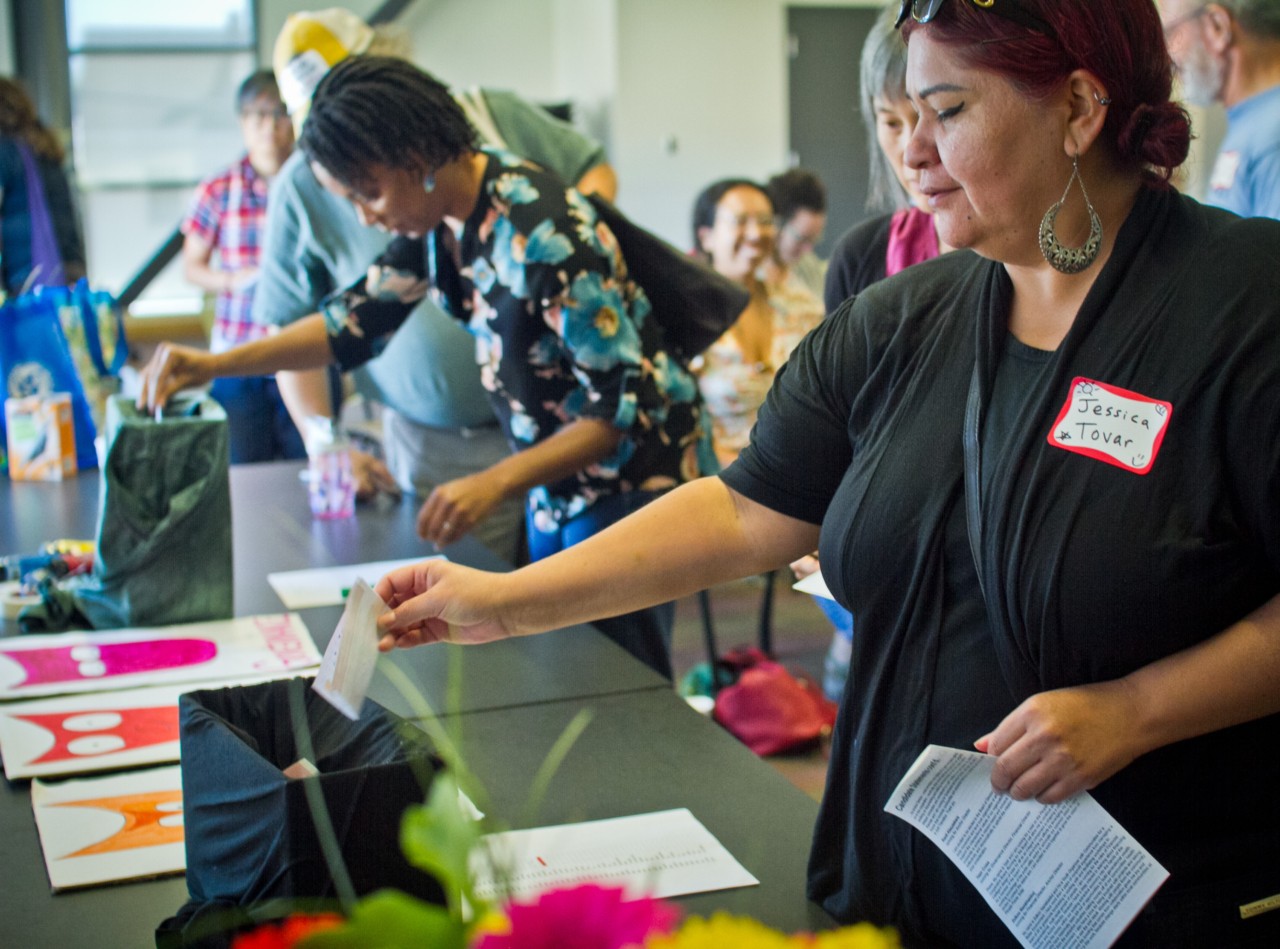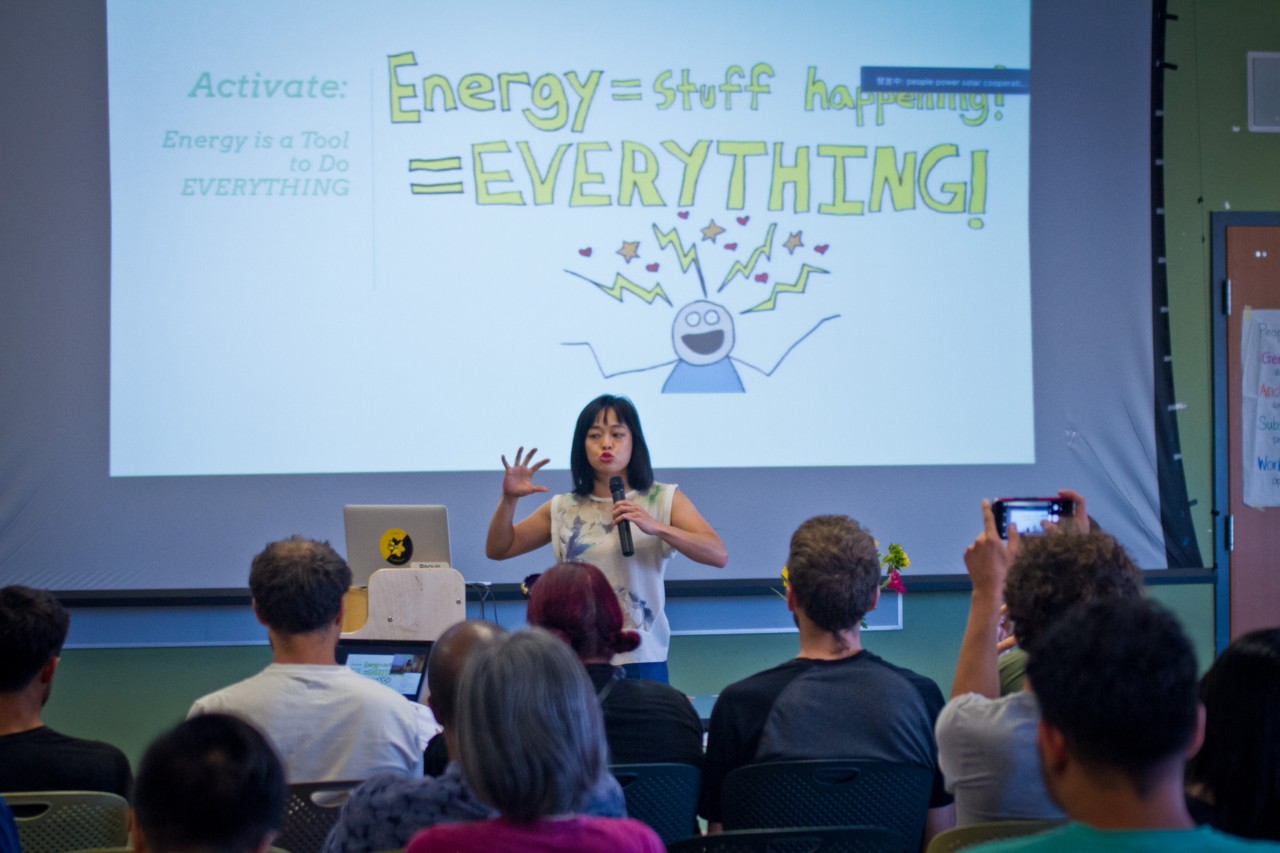

Photograph by fhm / Getty Images
Words by Daisy Clague
At COP26, Glasgow Botanic Gardens was home to a whisper of moths made from recycled milk bottles. Fluttering amongst tree ferns in the gardens’ domed glasshouse, the moths had been made and sent by 58,000 people who were not traveling to the COP but who wanted to be represented there.
“Mass participation artworks are a way for people to join in at the level that they feel able,” said Chloë Uden, founder and director of the Art and Energy Collective, which curated the installation. The Art and Energy Collective is a group of creatives whose aim is to inspire behavior change not by promoting specific climate solutions, but by giving people the space, resources, and permission to respond to the climate emergency in their own ways. Moths to a Flame invited participants to reflect on where our energy comes from, not just in the literal sense—from where do we get our electricity?—but existentially: Where does our power come from? And what might we do with it?
Nearly two years on from COP26, the questions posed by Moths to a Flame continue to be just as relevant today as our relationship to energy approaches a historic turning point. New projections by the International Energy Agency (IEA) show that, for the first time since industrialization, demand for fossil fuels is set to peak before 2030, prompting the IEA’s Executive Director Fatih Birol to declare “the beginning of the end of the fossil fuel era.”
But who gets to decide what the next era looks like? Much of the westernized world upholds a centralized corporate energy system where private suppliers reign, extracting wealth from communities and prioritizing shareholder profits over the essential needs of the people: a resilient grid and safe, affordable electricity.
“When we constantly talk about renewable energy as a solution, we’re not really talking about who has the power: literally, politically and financially. We’re completely missing the point,” said Crystal Huang, national coordinator of the Energy Democracy Project, a collaboration of energy democracy organizers from across the United States. Yes, renewables are undoubtedly better for our planet than fossil fuels, but decarbonizing the grid will not in itself address the extractive nature of our existing system.
Enter: community energy groups and energy democracy campaigners, who are reimagining an alternative energy future from the ground up. Like the Art and Energy Collective, many community energy advocates are also artists who use their creative skills to help people recognize that the structure of our energy system is not set in stone.

Energy democracy is a framework that envisions a decentralized, democratized, and redistributed energy system. In practice, energy democracy is often embodied by renewable energy community groups that own and run clean energy projects to meet their own energy needs. Renewable energy communities might sound like they occupy the utopian fringes of the energy transition but they are in fact significant players in the era that lies ahead. A 2016 study by the University of Delft found that, by 2030, around half of all EU households—113 million —could be producing renewable energy, either individually or through a collective. The movement has been aided by recent EU-level legislation, which indicates a more purposeful approach to reinforcing energy communities in Europe than in the United States. But the U.S. is nonetheless home to a burgeoning and varied energy democracy movement.
To thrive at scale, renewable energy communities need a supportive regulatory framework, and for governments and municipalities to provide the financial support and technical know-how that allow communities to own and govern their power. But energy democracy begins by reshaping the stories we have come to believe about our relationship to power, to nature, and to each other.
Yes, renewables are undoubtedly better for our planet than fossil fuels, but decarbonizing the grid will not in itself address the extractive nature of our existing system.
Most people know electricity as the thing that comes from a plug in the wall, and don’t think about it much beyond that. “Our relationship with energy is pigeonholed into consumer,” said Huang. “We have been told to just pay our bills and not worry about what’s happening at the back-end.” This is what British artists and filmmakers Dan Edelstyn and Hilary Powell are trying to change with their ongoing community project, POWER. Their mission is to install solar panels on the roof of every house in their North London street and are filming the process to create an “irreverent, anarchic, and joyful” feature documentary that also functions as a manifesto for energy democracy. Edelstyn and Powell are putting human stories at the heart of what—in less creative hands—could have otherwise been a mundane process of getting solar infrastructure installed. “It doesn’t touch their hearts if you just start talking about science or technology,” Dan told Atmos.
Melanie La Rosa is another filmmaker with a similar passion, who is based on the other side of the Atlantic. Her documentary, How to Power a City, details the development of the clean energy revolution in seven cities across the United States. When she began research for the film, Melanie found that the mainstream narrative around the energy transition was of citizens as spectators, waiting for Musk, Buffett, or Bloomberg to come up with a plan. “I was like, Why can I only read about billionaires? What about what other people are doing?,” she said. And so, La Rosa set out to film communities whose stories get right to the heart of why community energy is so intimately linked to energy justice.
In 2011, the utility repossessed over 1,000 streetlights in Highland Park, Michigan, a low-income, primarily African-American community where over 30% of the population live in poverty. The town was left in darkness. In response, a group of residents formed Soulardarity, an energy democracy group that has since installed solar-powered street lights—complete with a mesh wifi system—to replace the ones that were repossessed, and educated residents on how energy relates to poverty and democracy. “They are taking something that is so distant for most of us—it’s so abstract and unreachable, the utility—and making it their own,” La Rosa said.

It’s not to say that solar panels are a perfect solution. In fact, producing renewables infrastructure often involves exploitative labor practices and resource extraction that can be environmentally fraught, and primarily takes place in the Global South. But, by bringing together stories of popular resistance to centralized fossil power and sharing them around the world, La Rosa hopes How to Power a City will give people concrete ideas of what they could achieve in their own communities.
Other energy democracy artist-activists are challenging the prevailing paradigm of energy-as-commodity by asking questions about what energy actually is. The Energy Democracy Project aims to redefine energy as the “life and labor of the living system,” rather than something we pump, frack, and mine for consumption. Huang is also part of a solar cooperative in California that seeks to reframe “energy as a verb” that drives the seasons and moves the sun across the sky; that allows us to breathe and experience the world. While she acknowledges that this abstract language doesn’t suit everyone, it is an attempt to give people clarity on the role of energy in their lives.
Such examples of playful storytelling are reminiscent of the work of the Art and Energy Collective. For Uden, the collective’s founder, bringing art and energy together means “enjoying the subtle poetry of renewables,” she said. Yes, she wants everyone to put solar panels on their house, “but what is it that takes someone on that journey?” Her intention is to meet people where they are, evoking energy democracy through mass participation artworks that quite literally let everyone join in.
But activists also stress the importance of recognizing the contradictions within the energy democracy movement. “If we are to ramp up production of solar and battery storage, that is going to mean ramping up the extraction of lithium in the Global South,” said Selena Feliciano, an organizer, actor and musician who works with Huang at the Energy Democracy Project, coordinating their campaign to Reimagine Energy For Our Communities U.S. (REFOCUS). The mining in solar panel and battery supply chains perpetuates colonial-era extractivism and has been linked to human rights abuses and environmental harm. Scholar and climate justice activist Ashley Dawson discusses these thorny tensions in his book, People’s Power. “Genuine victories of popular struggles for energy democracy… are ultimately reliant on the very relations of production that they are striving to overthrow,” he writes.
But Feliciano also believes that when people reconsider their own relationship to energy, it provides an opportunity to recognize how our decisions at home have real impacts everywhere else. Bringing power to the people can thus be a catalyst for global systemic change. “When we look to energy sources that are more in tune with our local ecologies, that opens up a whole world of awareness about the ways in which we interact with each other as a global community.”
The Artist-Activists Ushering In a New Energy Democracy

